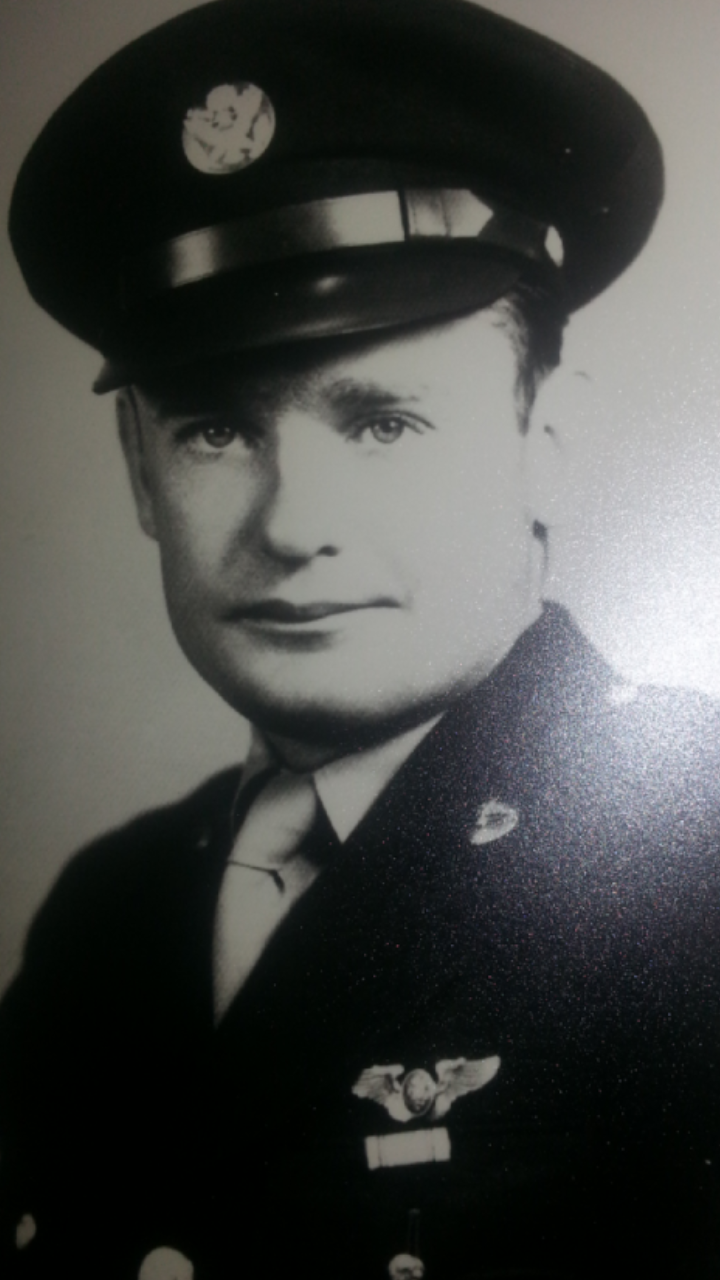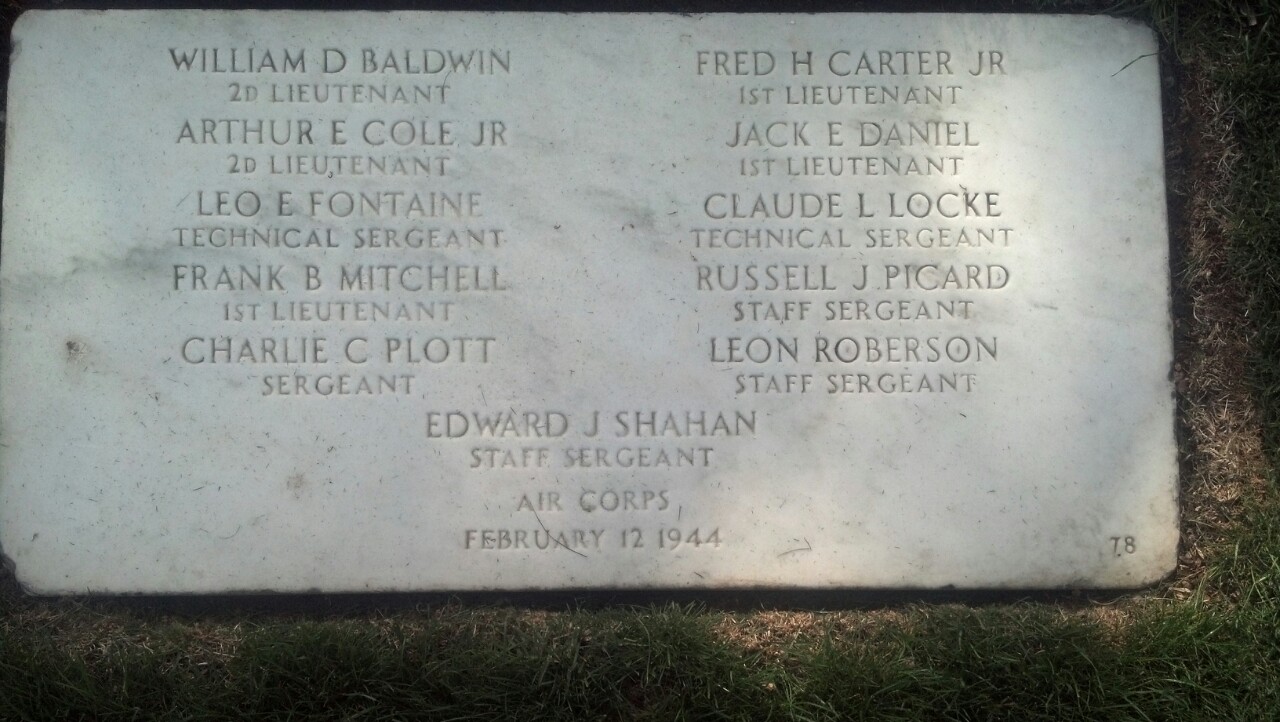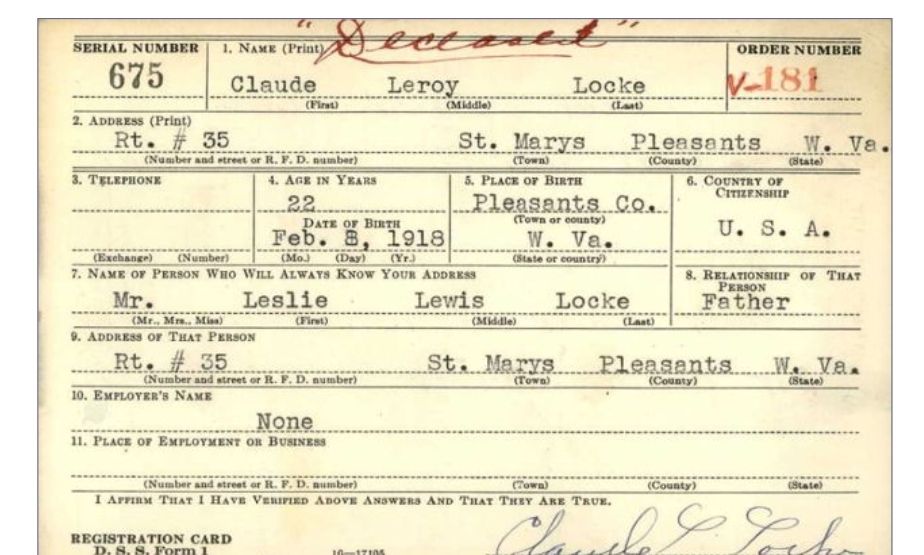Claude was flying on the B-24J Liberator bomber, Sn #42-72818 (MACR 2292), piloted by Lt. Fred H. Carter. They were assigned to the 372nd Bomb Squadron, 307th Bomb Group, 13th Air Force. Claude was the plane's Engineer and also served as an Aerial Gunner. His plane was shot down on 2/12/1944 over Vunakanau, Rabaul, New Guinea, by enemy anti-aircraft (AA)fire.
The crew roster on 2/12/1944 was as follows:
Pilot 1st Lt Fred H. Carter, O-740056
Co-Pilot 2nd Lt Arthur E. Cole Jr., O-679715
Navigator 1st Lt Frank B. Mitchell, O-670780
Bombardier 1st Lt Jack Edward Daniel, O-668706
Engineer T/Sgt Claude L. Locke, 35209813
Ass't Engineer S/Sgt Leon Roberson, 37102692
Radio Op T/Sgt Leo E. Fontaine, 11033879
Ass't Radio S/Sgt Russell J. Picard, 18149304
Gunner Sgt Charlie C. Plott, 19018059
Armorer/Gunner S/Sgt Edward J. Shahan, 38187482
Observer 2nd Lt William D. Baldwin, O-743807
Witnesses from other aircraft saw the plane get hit and noted that the aircraft seemed to right itself after being briefly out of control but then started its downward plunge to the ground. The plane was hit in the vicinity of the flight deck. The shell seemed to burst inside the ship and soon afterwards the plane fell out of formation and crashed. During this AA attack, a sister bomber flown by Lt. Leslie J. Carson, Jr. was hit five times by the AA fire. Another bomber, flown by a Lt. Mather, received three hits. A third bomber flown by Lt. Homer Faucett was hit twice and Lt. Mark J. Rifkin's plane was hit by a piece of Carter's plane. It was reported that one, possibly two parachutes were seen but this was not confirmed. According to eye-witness reports from other bomber crews, men were observed bailing out of Carter's plane and were fired upon by enemy AA.
Neither the plane nor the crew was heard from again until 1948 when, at the request of the mother of Lt. Jack E. Daniel, the Army Grave Registration Team began an investigation and eventually located the crash site. On 12/11/1948, the team reached the wreakage site and the first set of remains found were scattered "from the outboard end of the wing section to about five yards away". These remains turned out to be Sgt. Charlie Carter Plott's remains and were identified by the discovery of his dog tags amongst the bones. The body had not been buried but was partially covered by jungle growth and rain debris. Another set of remains was discovered on 12/13 that bore no identification. Then a third set of remains, spread over a five yard area were located scattered under close to the wing section. These were identified as belonging to S/Sgt Leon Roberson. Next was found an identification bracelet for T/Sgt. Russell Picard and then a bracelet for Leon Roberson. Jack Roberson, the brother of Leon Roberson, told this author that he was told it was his brother whose body was hanging from the trees and that the identification bracelet found was actually being worn by a native boy and given to the site investigators. The MACR report states Roberson's remains were found under a wing at the crash site and his identification bracelet was found there. Jack now has that bracelet. Approximately thirty yards from the wing section, a shoulder bone was discovered by itself. Approximately five yards from the wrecked fuselage, under portions of a machine gun ball turret wreckage, a small number of bones were located with a dog tag belonging to S/Sgt Russll J. Picard. On 12/23, a final visit was made to the site and several more bone fragments were recovered. The MACR reports that, "Four depressions in the ground in the wreckage area were viewed. It is possible that these may have been excavated graves as each was the approximate size of a grave. Digging in the depression failed to unearth remains." Villagers in the area stated that four bodies were buried next to the plane after the crash but at some point an Australian Sergeant (probably a "Coast-watcher") and a civilian came through the area and exhumed the bodies & took them away. It is unknown at this point whose bodies they were or what happened to them. The natives also reported that two parachutes did land in the area of the crash and reported seeing one of the chutes suspended in a tree with a body connected to it. They did not stay in the area very long as the Japanese soldiers ran them off. They stated the Japanese carried the body away. It is unknown what happened to the second parachutist but we probably have a pretty good idea what occurred if he lived from his jump.
A total of eleven men were on the bomber when it departed on its mission to Rabaul. At the crash site, four sets of remains were believed to have been recovered with four others being buried then removed by persons unknown. That makes for eight members of the crew. If two men did parachute to the ground it is clear they were either killed in their descent or by the Japanese. That makes 10 men. It is unknown if the shoulder bone found at the wreck site belonged to one of the other bodies or if it may have been the shoulder of the eleventh man. The recovered remains were buried together at Jefferson Barracks National Cemetery, St. Louis, MO in 1950.
It is believed the bomber that the crew was flying that day did not yet have a name while others think it was "The Wicked Wench". The "Wench" was the plane Carter originally flew as co-pilot to the South Pacific and was the one his crew normally flew on. It is also the plane they had their crew photo shot by. The crew on their last mission was essentially the same as the one that flew "the Wench" from United States territories. The original commander of that first crew had been Captain John Penington. Captain Penington had flown the Wicked Wench to Guadalcanal via Midway and some of the crew in the photo with this memorial had made that first trip with him. Carter was his co-pilot then and when Penington moved on to S-2, Carter took over as plane commander/pilot. The original bombardier, Lt. Harold Mote or Motes, also left the crew in January 1944. He rotated back to the States for a training course. Lt. Jack Daniel, who was already in the 307th but with a different crew, transferred to Carter's team that same month. 2nd Lt. Arthur Cole joined the crew as the new co-pilot. SSgt Leon Roberson joined as the new Assistant Engineer/Gunner when original crewman Miller was reassigned. Lt. William D. Baldwin was on the aircraft that day strictly as an "Observer".
Below is the Western Union telegram crew member Sgt. Charlie Plott's wife received from the Department of the Army. All crew members families received essentially the same telegram as follows (names of course would be different on each telegram):
"THE SECRETARY OF WAR DESIRES ME TO EXPRESS HIS DEEP REGRET THAT YOUR HUSBAND SERGEANT CHARLIE C PLOTT HAS BEEN REPORTED MISSING IN ACTION SINCE TWELVE FEBRUARY OVER NEW BRITAIN PERIOD IF FURTHER DETAILS OR OTHER INFORMATION ARE RECEIVED YOU WILL BE PROMPTLY NOTIFIED PERIOD=
ULIO THE ADJUTANT GENERAL".
The Carter Crew were listed as Missing in Action (MIA) until they were officially declared dead on 1/18/1946 after the end of the war. As of this writing, it is believed Claude Locke's remains were one of the four that were buried and then dug up by the Austrailians. The final disposition of his remains is unknown. The marker at Jefferson Barracks with his name and the names of the other crew members does not mean that all of their remains are there but is there as a memorial to their service and sacrifice.
Technical Sergeant Claude L. Locke, Sn# 35209813, earned the following badges/decorations during WWII:
- Army Air Corps Gunner Wings
- Distinguished Flying Cross
- Air Medal with seven Oak Leaf Clusters
- Purple Heart Medal
- Army Good Conduct Medal
- American Defense Medal
- Asiatic Pacific Campaign Medal
- American Campaign Medal
- WWII Victory Medal
- Army of Occupation Medal (awarded to his unit after the war ended and while he was listed with the 307th as MIA)
- Philippine Liberation Medal
- Philippine Presidential Unit Citation
Claude was flying on the B-24J Liberator bomber, Sn #42-72818 (MACR 2292), piloted by Lt. Fred H. Carter. They were assigned to the 372nd Bomb Squadron, 307th Bomb Group, 13th Air Force. Claude was the plane's Engineer and also served as an Aerial Gunner. His plane was shot down on 2/12/1944 over Vunakanau, Rabaul, New Guinea, by enemy anti-aircraft (AA)fire.
The crew roster on 2/12/1944 was as follows:
Pilot 1st Lt Fred H. Carter, O-740056
Co-Pilot 2nd Lt Arthur E. Cole Jr., O-679715
Navigator 1st Lt Frank B. Mitchell, O-670780
Bombardier 1st Lt Jack Edward Daniel, O-668706
Engineer T/Sgt Claude L. Locke, 35209813
Ass't Engineer S/Sgt Leon Roberson, 37102692
Radio Op T/Sgt Leo E. Fontaine, 11033879
Ass't Radio S/Sgt Russell J. Picard, 18149304
Gunner Sgt Charlie C. Plott, 19018059
Armorer/Gunner S/Sgt Edward J. Shahan, 38187482
Observer 2nd Lt William D. Baldwin, O-743807
Witnesses from other aircraft saw the plane get hit and noted that the aircraft seemed to right itself after being briefly out of control but then started its downward plunge to the ground. The plane was hit in the vicinity of the flight deck. The shell seemed to burst inside the ship and soon afterwards the plane fell out of formation and crashed. During this AA attack, a sister bomber flown by Lt. Leslie J. Carson, Jr. was hit five times by the AA fire. Another bomber, flown by a Lt. Mather, received three hits. A third bomber flown by Lt. Homer Faucett was hit twice and Lt. Mark J. Rifkin's plane was hit by a piece of Carter's plane. It was reported that one, possibly two parachutes were seen but this was not confirmed. According to eye-witness reports from other bomber crews, men were observed bailing out of Carter's plane and were fired upon by enemy AA.
Neither the plane nor the crew was heard from again until 1948 when, at the request of the mother of Lt. Jack E. Daniel, the Army Grave Registration Team began an investigation and eventually located the crash site. On 12/11/1948, the team reached the wreakage site and the first set of remains found were scattered "from the outboard end of the wing section to about five yards away". These remains turned out to be Sgt. Charlie Carter Plott's remains and were identified by the discovery of his dog tags amongst the bones. The body had not been buried but was partially covered by jungle growth and rain debris. Another set of remains was discovered on 12/13 that bore no identification. Then a third set of remains, spread over a five yard area were located scattered under close to the wing section. These were identified as belonging to S/Sgt Leon Roberson. Next was found an identification bracelet for T/Sgt. Russell Picard and then a bracelet for Leon Roberson. Jack Roberson, the brother of Leon Roberson, told this author that he was told it was his brother whose body was hanging from the trees and that the identification bracelet found was actually being worn by a native boy and given to the site investigators. The MACR report states Roberson's remains were found under a wing at the crash site and his identification bracelet was found there. Jack now has that bracelet. Approximately thirty yards from the wing section, a shoulder bone was discovered by itself. Approximately five yards from the wrecked fuselage, under portions of a machine gun ball turret wreckage, a small number of bones were located with a dog tag belonging to S/Sgt Russll J. Picard. On 12/23, a final visit was made to the site and several more bone fragments were recovered. The MACR reports that, "Four depressions in the ground in the wreckage area were viewed. It is possible that these may have been excavated graves as each was the approximate size of a grave. Digging in the depression failed to unearth remains." Villagers in the area stated that four bodies were buried next to the plane after the crash but at some point an Australian Sergeant (probably a "Coast-watcher") and a civilian came through the area and exhumed the bodies & took them away. It is unknown at this point whose bodies they were or what happened to them. The natives also reported that two parachutes did land in the area of the crash and reported seeing one of the chutes suspended in a tree with a body connected to it. They did not stay in the area very long as the Japanese soldiers ran them off. They stated the Japanese carried the body away. It is unknown what happened to the second parachutist but we probably have a pretty good idea what occurred if he lived from his jump.
A total of eleven men were on the bomber when it departed on its mission to Rabaul. At the crash site, four sets of remains were believed to have been recovered with four others being buried then removed by persons unknown. That makes for eight members of the crew. If two men did parachute to the ground it is clear they were either killed in their descent or by the Japanese. That makes 10 men. It is unknown if the shoulder bone found at the wreck site belonged to one of the other bodies or if it may have been the shoulder of the eleventh man. The recovered remains were buried together at Jefferson Barracks National Cemetery, St. Louis, MO in 1950.
It is believed the bomber that the crew was flying that day did not yet have a name while others think it was "The Wicked Wench". The "Wench" was the plane Carter originally flew as co-pilot to the South Pacific and was the one his crew normally flew on. It is also the plane they had their crew photo shot by. The crew on their last mission was essentially the same as the one that flew "the Wench" from United States territories. The original commander of that first crew had been Captain John Penington. Captain Penington had flown the Wicked Wench to Guadalcanal via Midway and some of the crew in the photo with this memorial had made that first trip with him. Carter was his co-pilot then and when Penington moved on to S-2, Carter took over as plane commander/pilot. The original bombardier, Lt. Harold Mote or Motes, also left the crew in January 1944. He rotated back to the States for a training course. Lt. Jack Daniel, who was already in the 307th but with a different crew, transferred to Carter's team that same month. 2nd Lt. Arthur Cole joined the crew as the new co-pilot. SSgt Leon Roberson joined as the new Assistant Engineer/Gunner when original crewman Miller was reassigned. Lt. William D. Baldwin was on the aircraft that day strictly as an "Observer".
Below is the Western Union telegram crew member Sgt. Charlie Plott's wife received from the Department of the Army. All crew members families received essentially the same telegram as follows (names of course would be different on each telegram):
"THE SECRETARY OF WAR DESIRES ME TO EXPRESS HIS DEEP REGRET THAT YOUR HUSBAND SERGEANT CHARLIE C PLOTT HAS BEEN REPORTED MISSING IN ACTION SINCE TWELVE FEBRUARY OVER NEW BRITAIN PERIOD IF FURTHER DETAILS OR OTHER INFORMATION ARE RECEIVED YOU WILL BE PROMPTLY NOTIFIED PERIOD=
ULIO THE ADJUTANT GENERAL".
The Carter Crew were listed as Missing in Action (MIA) until they were officially declared dead on 1/18/1946 after the end of the war. As of this writing, it is believed Claude Locke's remains were one of the four that were buried and then dug up by the Austrailians. The final disposition of his remains is unknown. The marker at Jefferson Barracks with his name and the names of the other crew members does not mean that all of their remains are there but is there as a memorial to their service and sacrifice.
Technical Sergeant Claude L. Locke, Sn# 35209813, earned the following badges/decorations during WWII:
- Army Air Corps Gunner Wings
- Distinguished Flying Cross
- Air Medal with seven Oak Leaf Clusters
- Purple Heart Medal
- Army Good Conduct Medal
- American Defense Medal
- Asiatic Pacific Campaign Medal
- American Campaign Medal
- WWII Victory Medal
- Army of Occupation Medal (awarded to his unit after the war ended and while he was listed with the 307th as MIA)
- Philippine Liberation Medal
- Philippine Presidential Unit Citation
Inscription
TSGT, US ARMY AIR FORCES WORLD WAR II
Sponsored by Ancestry
Advertisement
Explore more
Sponsored by Ancestry
Advertisement






